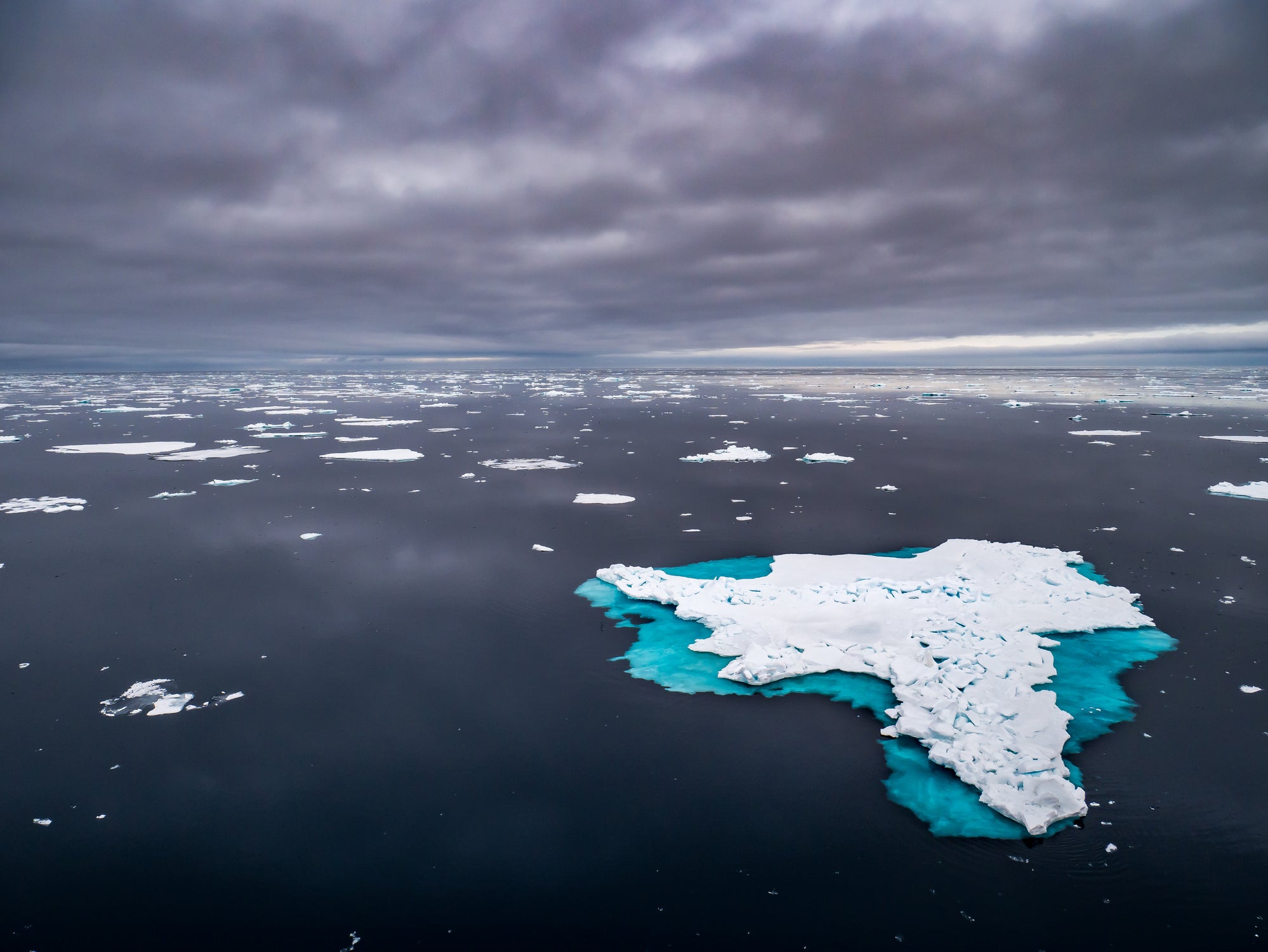This website uses cookies so that we can provide you with the best user experience possible. Cookie information is stored in your browser and performs functions such as recognising you when you return to our website and helping our team to understand which sections of the website you find most interesting and useful.

A major ocean current in the Arctic could reverse amid warming temperatures, a change which would bring significantly colder weather to western Europe, scientists at Nasa have warned.
The circular current, called the Beaufort Gyre, moves in a clockwise direction around the western Arctic Ocean, north of Canada and Alaska, where it naturally collects freshwater from glacial melt, river run-off and precipitation.
This freshwater protects sea ice from salty water which would melt it faster, and helps keep the north of the planet cool.
But increasingly rapid ice-melt due to climate change means the current has picked up unusually large amounts of freshwater and exposed it to the air, causing it to move faster and become more turbulent.
Using 12 years of satellite data, scientists have measured how this circular current has precariously balanced an influx of unprecedented amounts of cold, freshwater, and how this equilibrium could soon break down.
Created with Sketch.
Created with Sketch.
1/52 Chicago
Ice covers the Lake Michigan shoreline
Getty
2/52 Minnesota
A firefighter walks past an ice-encrusted home after an early morning house fire
AP
3/52 Ontario
People walk in a park on the US side of Niagara Falls
AFP/Getty
4/52 Massachusetts
Mike Calen, left, and Steve Goyette, right, prepare to tie off as the ice covered fishing boat, Buzzards Bay, arrives at New Bedford harbour
AP
5/52
Pedestrians protecting their faces from the cold in New York City, in Washington DC, along Lake Michigan's ice covered shoreline, in the Brooklyn borough of New York, in Chicago, in Kingston, Ontario, and in Montreal
AFP/Getty
6/52 Chicago
Snow and ice covers Soldier Field
Getty Images
7/52 Chicago
Gas-burning heaters are placed on railroad tracks as Metra commuter train passes by
EPA
8/52 Chicago
Ice builds up along the shore of Lake Michigan
Getty Images
9/52 Ontario
A tree is covered in ice from the mist at park beside the falls in Niagara Falls
AFP/Getty Images
10/52 Minneapolis
Water vapor rises above St. Anthony Falls on the Mississippi River beneath the Stone Arch Bridge
AFP/Getty
11/52 Massachusetts
Ice flows fill the Merrimack River as it heads towards the Atlantic Ocean in Newburyport
AFP/Getty Images
12/52 Ontario
A tourists take pictures of the Canadian Horseshoe falls in Niagara Falls
AFP/Getty
13/52 Minneapolis
Sub-zero temperatures produce icicles that hang from a restaurant
EPA
14/52 Ontario
A person takes a selfie beside on the US side of Niagara Falls
AFP/Getty Images
15/52
AFP/Getty Images
16/52 Minneapolis
Water vapor from the Mississippi River envelopes a bridge as sub-zero temperatures produce dangerous windchills
EPA
17/52 New York
Pedestrians walk through the falling snow in the Financial District
Getty
18/52 Ontario
Steam rises from the US Niagara Falls before sunrise
AFP/Getty
19/52 Chicago
Snow covers Wrigley Field entrance
Reuters
20/52 New York
Workers shovel at the entrance to City Hall in whiteout conditions
Reuters
21/52
NASA's 'Blue Marble' data set of weather systems over the continental United States
US National Oceanic and Atmospheric Administration/EPA
22/52 Chicago
Ice and snow builds up along Lake Michigan
EPA
23/52 Minneapolis
EPA
24/52 Minneapolis
Chuck Carpenter is frost covered as he goes for a walk
EPA
25/52 Chicago
A man walks along the lakefront as temperatures hovered around -20 degrees
Getty
26/52 Chicago
Frozen Chicago River
Reuters
27/52 New York
A man walks next to a subway train as heavy snow falls
AFP/Getty
28/52 Chicago
A digital board shows flight cancellations at Terminal 3 at O'Hare International Airport
EPA
29/52 Chicago
Reuters
30/52 Chicago
A shirt that was hung is seen frozen
Terry Greenbeans/Reuters
31/52 Chicago
People walk along the lakefront
Getty Images
32/52 New York
A young man waits on a subway platform in freezing temperatures
AFP/Getty Images
33/52 Chicago
Mist rises from the city and Lake Michigan
EPA
34/52 New York
People walk through the snow in lower Manhattan
Getty Images
35/52 Chicago
The James Versluis breaks ice on the frozen Chicago River near Navy Pier
EPA
36/52 Michigan
Reuters
37/52 Minneapolis
AFP/Getty
38/52 Chicago
EPA
39/52 New York
Reuters
40/52 Chicago
EPA
41/52 Chicago
AP
42/52 Michigan
Reuters
43/52 New York
AP
44/52 Chicago
Getty
45/52 New York
AP
46/52 Chicago
EPA
47/52 Minneapolis
AFP/Getty
48/52 Chicago
AP
49/52 Chicago
Reuters
50/52 Chicago
EPA
51/52 Chicago
EPA
52/52 Chicago
Getty
1/52 Chicago
Ice covers the Lake Michigan shoreline
Getty
2/52 Minnesota
A firefighter walks past an ice-encrusted home after an early morning house fire
AP
3/52 Ontario
People walk in a park on the US side of Niagara Falls
AFP/Getty
4/52 Massachusetts
Mike Calen, left, and Steve Goyette, right, prepare to tie off as the ice covered fishing boat, Buzzards Bay, arrives at New Bedford harbour
AP
5/52
Pedestrians protecting their faces from the cold in New York City, in Washington DC, along Lake Michigan's ice covered shoreline, in the Brooklyn borough of New York, in Chicago, in Kingston, Ontario, and in Montreal
AFP/Getty
6/52 Chicago
Snow and ice covers Soldier Field
Getty Images
7/52 Chicago
Gas-burning heaters are placed on railroad tracks as Metra commuter train passes by
EPA
8/52 Chicago
Ice builds up along the shore of Lake Michigan
Getty Images
9/52 Ontario
A tree is covered in ice from the mist at park beside the falls in Niagara Falls
AFP/Getty Images
10/52 Minneapolis
Water vapor rises above St. Anthony Falls on the Mississippi River beneath the Stone Arch Bridge
AFP/Getty
11/52 Massachusetts
Ice flows fill the Merrimack River as it heads towards the Atlantic Ocean in Newburyport
AFP/Getty Images
12/52 Ontario
A tourists take pictures of the Canadian Horseshoe falls in Niagara Falls
AFP/Getty
13/52 Minneapolis
Sub-zero temperatures produce icicles that hang from a restaurant
EPA
14/52 Ontario
A person takes a selfie beside on the US side of Niagara Falls
AFP/Getty Images
15/52
AFP/Getty Images
16/52 Minneapolis
Water vapor from the Mississippi River envelopes a bridge as sub-zero temperatures produce dangerous windchills
EPA
17/52 New York
Pedestrians walk through the falling snow in the Financial District
Getty
18/52 Ontario
Steam rises from the US Niagara Falls before sunrise
AFP/Getty
19/52 Chicago
Snow covers Wrigley Field entrance
Reuters
20/52 New York
Workers shovel at the entrance to City Hall in whiteout conditions
Reuters
21/52
NASA's 'Blue Marble' data set of weather systems over the continental United States
US National Oceanic and Atmospheric Administration/EPA
22/52 Chicago
Ice and snow builds up along Lake Michigan
EPA
23/52 Minneapolis
EPA
24/52 Minneapolis
Chuck Carpenter is frost covered as he goes for a walk
EPA
25/52 Chicago
A man walks along the lakefront as temperatures hovered around -20 degrees
Getty
26/52 Chicago
Frozen Chicago River
Reuters
27/52 New York
A man walks next to a subway train as heavy snow falls
AFP/Getty
28/52 Chicago
A digital board shows flight cancellations at Terminal 3 at O'Hare International Airport
EPA
29/52 Chicago
Reuters
30/52 Chicago
A shirt that was hung is seen frozen
Terry Greenbeans/Reuters
31/52 Chicago
People walk along the lakefront
Getty Images
32/52 New York
A young man waits on a subway platform in freezing temperatures
AFP/Getty Images
33/52 Chicago
Mist rises from the city and Lake Michigan
EPA
34/52 New York
People walk through the snow in lower Manhattan
Getty Images
35/52 Chicago
The James Versluis breaks ice on the frozen Chicago River near Navy Pier
EPA
36/52 Michigan
Reuters
37/52 Minneapolis
AFP/Getty
38/52 Chicago
EPA
39/52 New York
Reuters
40/52 Chicago
EPA
41/52 Chicago
AP
42/52 Michigan
Reuters
43/52 New York
AP
44/52 Chicago
Getty
45/52 New York
AP
46/52 Chicago
EPA
47/52 Minneapolis
AFP/Getty
48/52 Chicago
AP
49/52 Chicago
Reuters
50/52 Chicago
EPA
51/52 Chicago
EPA
52/52 Chicago
Getty
Since the 1990s, the gyre has accumulated a large volume of freshwater – 1,920 cubic miles (8,000 cubic km) – or almost twice the volume of Lake Michigan in the US.
The new study, published in Nature Communications, found the cause of this gain in freshwater concentration is the loss of sea ice in summer and autumn.
This long-term decline of the Arctic’s summertime ice cover has left the unfrozen sea much more exposed to the wind, which is therefore able to spin the gyre faster, trapping the freshwater in its current.
Persistent westerly winds have also dragged the current in one direction for over 20 years, increasing the speed and size of the clockwise current and preventing the freshwater from leaving the Arctic Ocean.
This decades-long western wind is unusual for the region, where previously the winds would change direction every five to seven years.
Scientists have been closely following the Beaufort Gyre in case the wind changes direction again.
If the direction were to change, the wind would then reverse the current, pulling it anticlockwise and releasing the water it has accumulated all at once.
“If the Beaufort Gyre were to release the excess freshwater into the Atlantic Ocean, it could potentially slow down its circulation. And that would have hemisphere-wide implications for the climate, especially in western Europe,” said Tom Armitage, lead author of the study and polar scientist at Nasa’s Jet Propulsion Laboratory in Pasadena, California.
This is because the release of the huge volume of freshwater from the Arctic Ocean into the north Atlantic could have a major effect on another vital ocean current system.
Freshwater is less dense than saltwater, so scientists fear the sudden release of thousands of cubic miles of freshwater could interfere with the current system known as Atlantic meridional overturning circulation.
This system keeps western Europe mild, due to the northward flow of warm, salty water in the upper layers of the Atlantic, and a southward flow of colder, deep waters.
Changes to this cycle could also affect the movement of organisms in the ocean, upon which many ecosystems depend.
“We don’t expect a shutting down of the Gulf Stream, but we do expect impacts. That’s why we’re monitoring the Beaufort Gyre so closely,” said Alek Petty, a co-author on the paper and polar scientist at Nasa’s Goddard Space Flight Centre.
The scientists said the results “reveal a delicate balance between wind and ocean as the sea ice pack recedes under climate change”.
“What this study is showing is that the loss of sea ice has really important impacts on our climate system that we’re only just discovering,” said Dr Petty.



 Africana55 Radio
Africana55 Radio 

